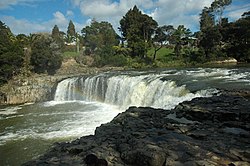Top Qs
Timeline
Chat
Perspective
Haruru, New Zealand
Locality in New Zealand From Wikipedia, the free encyclopedia
Remove ads
Haruru is a residential and commercial locality in the Far North District of New Zealand. State Highway 11 runs through the locality. Puketona is 10 kilometres west, and Paihia is 4 kilometres east, The name means a continuous noise or roar in the Māori language,[6] which refers to the sound of Haruru Falls, a five metre high broad waterfall about a kilometre away.[7]
Remove ads
History
The pool at the base of the falls was an early river port for Northland, with the Waitangi River providing access to the Bay of Islands. A hotel was built at Haruru in 1828, and a store was added to it about 1858.[8] The hotel burned down in 1937. It may have been the first licensed hotel in New Zealand.[9]
Demographics
Summarize
Perspective
Haruru covers 1.53 km2 (0.59 sq mi)[4] and had an estimated population of 1,230 as of June 2024,[10] with a population density of 804 people per km2.
Haruru had a population of 1,179 in the 2023 New Zealand census, an increase of 102 people (9.5%) since the 2018 census, and an increase of 312 people (36.0%) since the 2013 census. There were 582 males, 591 females and 3 people of other genders in 447 dwellings.[13] 2.3% of people identified as LGBTIQ+. The median age was 48.8 years (compared with 38.1 years nationally). There were 210 people (17.8%) aged under 15 years, 138 (11.7%) aged 15 to 29, 510 (43.3%) aged 30 to 64, and 321 (27.2%) aged 65 or older.[12]
People could identify as more than one ethnicity. The results were 78.1% European (Pākehā); 27.7% Māori; 3.8% Pasifika; 5.9% Asian; 1.5% Middle Eastern, Latin American and African New Zealanders (MELAA); and 1.5% other, which includes people giving their ethnicity as "New Zealander". English was spoken by 97.7%, Māori language by 7.6%, Samoan by 0.3% and other languages by 9.7%. No language could be spoken by 1.5% (e.g. too young to talk). New Zealand Sign Language was known by 0.3%. The percentage of people born overseas was 28.2, compared with 28.8% nationally.
Religious affiliations were 31.0% Christian, 1.0% Hindu, 2.5% Māori religious beliefs, 0.5% Buddhist, 0.3% New Age, and 1.5% other religions. People who answered that they had no religion were 56.7%, and 6.4% of people did not answer the census question.
Of those at least 15 years old, 141 (14.6%) people had a bachelor's or higher degree, 489 (50.5%) had a post-high school certificate or diploma, and 285 (29.4%) people exclusively held high school qualifications. The median income was $34,000, compared with $41,500 nationally. 54 people (5.6%) earned over $100,000 compared to 12.1% nationally. The employment status of those at least 15 was that 438 (45.2%) people were employed full-time, 141 (14.6%) were part-time, and 27 (2.8%) were unemployed.[12]
Remove ads
References
Wikiwand - on
Seamless Wikipedia browsing. On steroids.
Remove ads


